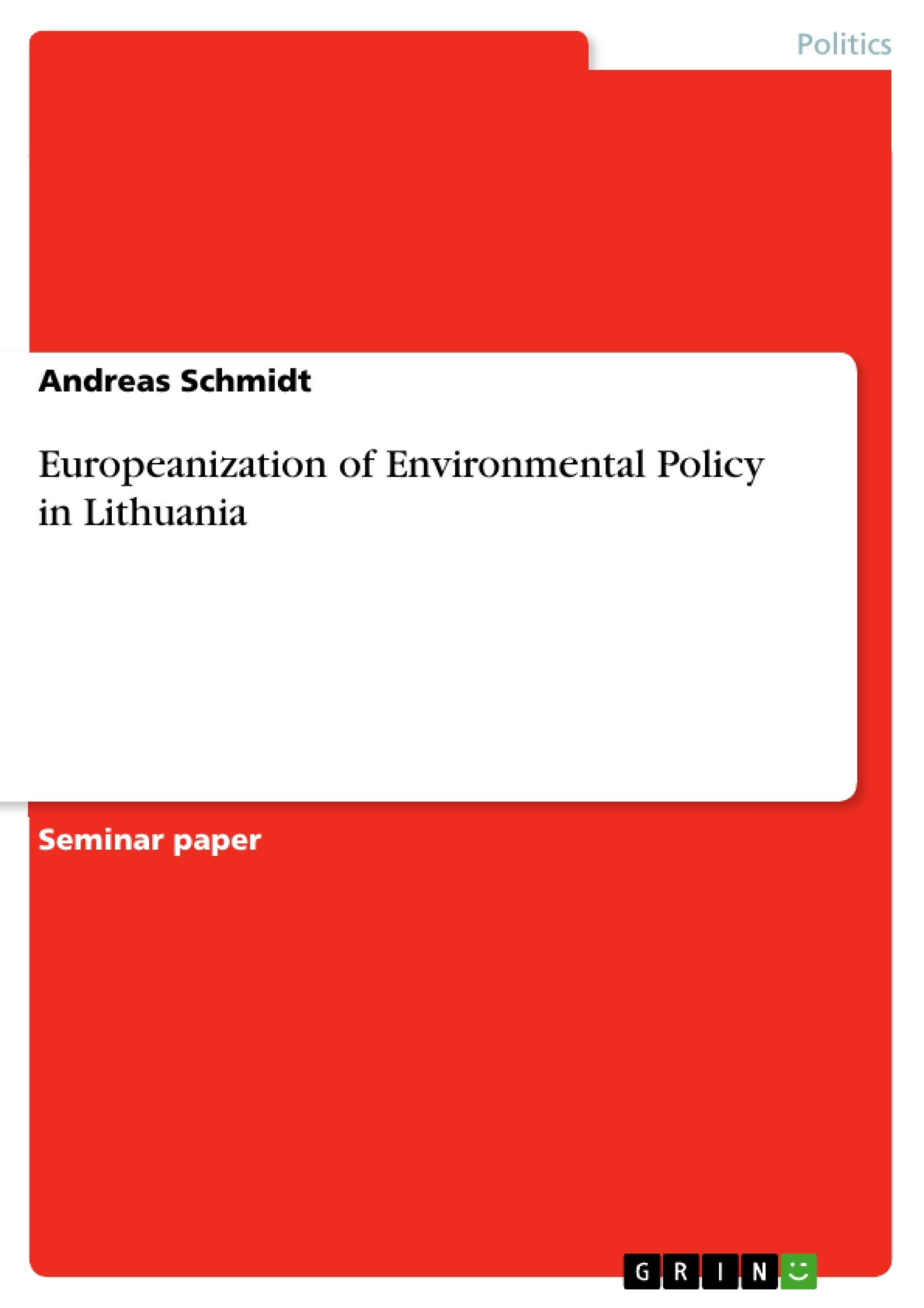Environmental policy in Lithuania emerged after regaining independence in the beginning of the 1990s. The young democracy had to build up a completely new legal system and institutions. At the same time this policy field has already matured on the EU-level as well as in its member states.
This paper focuses on the adaptation of Lithuanian environmental policy to the requirements of the EU and employs the concept of Europeanisation to explain changes. Europeanisation, as the term is used in this paper, is concerned with the consequences of European integration for the member and applicant states and politics within them.
It is found that especially through the accession process it was easy to ‘export’ EU rules and principles – firstly, because the pressure to adopt EU legislation was high and secondly, because local elites were ready to take EU templates.
After an introduction to the topic the second chapter presents an overview over EU environmental policy, whereas the third chapter focuses on Lithuanian environmental policy and the adaptations through the EU accession process. Chapter four then employs the concept of Europeanisation to explain the impact of EU environmental policy on Lithuanian domestic policy-making and its institutions.
Inhaltsverzeichnis (Table of Contents)
- 1. Introduction
- 2. Environmental Policy in the European Union
- 2.1 Development
- 2.2 Philosophies and Principles
- 2.3 Policy Output
- 2.4 Implementation and Enforcement
- 3. Emergence of Environmental Policy in Lithuania
- 3.1 Challenges and Development
- 3.2 Legal and Institutional framework
- 3.3 Policy Principles
- 4. Approximation to EU Environmental Policy.
- 4.1 Accession Process
- 4.2 Tasks and Course of Negotiations
- 4.3 Main challenges
- 4.3.1 Capacity-building
- 4.3.2 Financing the Adjustments
- 5. Concept of Europeanization
- 5.1 Defining Europeanization
- 5.2 Europeanization and Environmental Policy
- 5.3 Europeanization and Lithuania
- 6. Conclusion
Zielsetzung und Themenschwerpunkte (Objectives and Key Themes)
This essay examines the environmental policy of the European Union and how Lithuania has adapted to its requirements. It aims to understand the characteristics of European Union environmental policy, the development of Lithuanian environmental policy, and the challenges faced by Lithuania in adopting EU environmental legislation. This includes analyzing the impact of EU environmental policy on Lithuanian institutions.
- The evolution of European Union environmental policy and its key features
- The origins and development of Lithuanian environmental policy
- The challenges Lithuania faced and continues to face in adopting EU environmental legislation
- The influence of European Union environmental policy on Lithuanian domestic policy-making
- The impact of Europeanization on Lithuanian institutions
Zusammenfassung der Kapitel (Chapter Summaries)
- Chapter 2: Environmental Policy in the European Union: This chapter provides a broad overview of the development of environmental policy within the European Union. It explores the historical context of environmental policy, highlighting key philosophies and principles guiding its implementation. The chapter also covers the areas of Community activity in environmental policy and examines the gap between policy implementation and enforcement.
- Chapter 3: Emergence of Environmental Policy in Lithuania: This chapter focuses on the development of environmental policy in Lithuania, examining the challenges and key milestones in its evolution. It delves into the legal and institutional framework that shapes Lithuanian environmental policy, and explores the principles guiding its implementation.
- Chapter 4: Approximation to EU Environmental Policy: This chapter examines the process of Lithuania's accession to the European Union, specifically focusing on the environmental aspects of the accession negotiations. It explores the challenges posed by the EU environmental acquis for Lithuania's environmental sector, including capacity-building and financing the required adjustments.
- Chapter 5: Concept of Europeanization: This chapter delves into the concept of Europeanization and its application to environmental policy. It examines the definition of Europeanization and explores its influence on environmental policy within the European Union. Finally, the chapter analyzes the specific case of Europeanization and its impact on Lithuanian environmental policy and its institutions.
Schlüsselwörter (Keywords)
This essay focuses on the key terms and concepts related to European Union environmental policy, its implementation in Lithuania, and the process of Europeanization. Key themes include environmental policy, Europeanization, accession process, capacity-building, and the impact of EU environmental legislation on national environmental policies and institutions.
- Quote paper
- Andreas Schmidt (Author), 2005, Europeanization of Environmental Policy in Lithuania, Munich, GRIN Verlag, https://www.grin.com/document/60179



